#harvester ant
Text

harvestant nektlant and coloniant
harvestant and coloniant
based on the red harvester ant, endemic to Mexico and the US they are known for their relationship with plants as their primary food is seeds which they store in their nests, helping the seeds to disperse at the same time. they tend to have seed and rock trails surrounding their nest which makes it easier to identify them

[source1] [source2]
nektlant (nektli=nectar in nahuatl)
based on the honeypot ant, a strange species of ant where some members work as storage by keeping the food they ate on their abdomen and then climb to the ceiling where they stay attached untill the food is needed, these ants are also harvested by humans who sometimes eat the storage ants as candy, some even use their "honey" as medicine for certain illnesses

[source]
#my art#oc#oc art#creature design#fakemon#fakemon art#mesoma region#artists on tumblr#ant#harvester ant#honeypot ant
14 notes
·
View notes
Text

I am the ant - original piece by me
2nd in a six piece series based on Heather Morgan's value based integration exercise
link to first piece
#art#artbyrewcana#artists on tumblr#my art#oc#tumblr art#original art#photopea#ant#ant hill#digging ant#harvester ant#bug#bug art#insect art#insect#creature#creatures#worker ant#accomplishment
3 notes
·
View notes
Text

Harvesters.
#photographers on tumblr#harvester ants#Pogonomyrmex sp.#Black Phoebe Pond#San Pedro House#San Pedro Riparian National Conservation Area#Cochise County#Arizona
37 notes
·
View notes
Text
I just realized that Messor barbarus can't sting. And now I need to rethink something I thought was obvious about seed collecting ants.
Pogonomyrmex and Veromessor (the genuses of harvester ants we have in the Americas) can sting. It seems that much like "Army Ants" the group "harvester ants" isn't as cohesive as I thought.
That said... they are somewhat related, both practice social hybridogenesis.
I'm stunned. Ants shock me every single day! They can't keep getting away with this!
Please don't ask me to explain this yet I'm still trying to understand what the heck these ants are even doing.

#ant#ant propaganda#bugs#insects#myrmecology#antblr#bugblr#antposting#ant secrets#harvester ants#Hybridogenesis#reproductive system
20 notes
·
View notes
Text
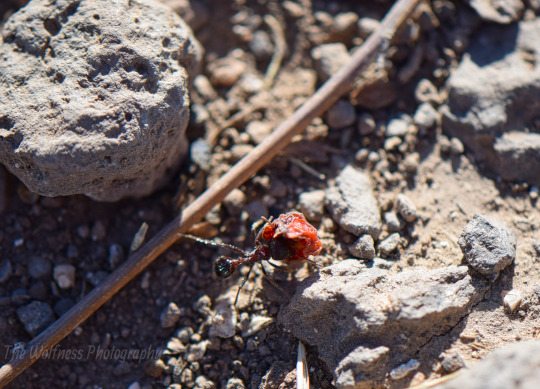
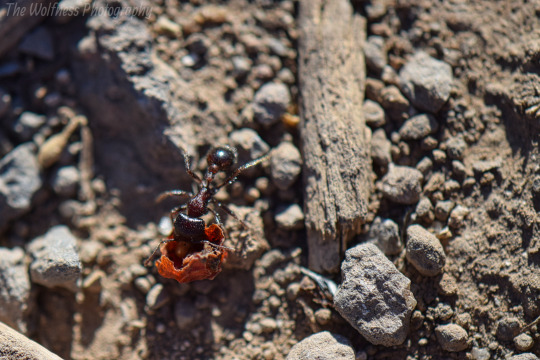

Desert harvester ant (Pogonomyrmex rugosus)
#nature#nature photography#macro#macro nature#macro photography#up close#up close photography#close up#close up photography#insect#insect photography#ant#ant photography#desert nature#sonoran desert#Desert harvester ant#Pogonomyrmex rugosus#photographer on tumblr#original photography#original photographers#original photography on tumblr#original photography blog#US#United States#united states of america#Arizona
23 notes
·
View notes
Text


btw this was the napping spot
if you even care
#j#me#it got cold after about 45min of just lying there tho#brought some big ass ants to the car#but then again so did my sister with her moss harvesting endeavors
23 notes
·
View notes
Text








Insectarium again, harvester ants got an upgrade
#invertebrates#invertiblr#inverts#invert#bugblr#scorpion#spider#harvester ants#insectarium#pdxinsectarium
14 notes
·
View notes
Text
It's been a moment since I uploaded any macrophotography. This harvester ant stumbled onto my jacket from somewhere so I carried her out, but I did take a moment to photo and video her. Looked a little sluggish at first but she wandered off under her own power quite capably.






Ants can be a real pain to photograph, they're small, dark, and skittish, not to mention many species are extremely shiny so they're hard to illuminate. One of the masters of ant photography is Alex Wild, a doctor of entomology at the University of Texas.
68 notes
·
View notes
Text
In the gray zone where you've read enough spoilers to know about some major events but not enough to know exactly how things go afterwards so you're even more distressed than if you hadn't read anything at all.
You will find me compulsively refreshing any review sites I can find until I have The Information.
#the paradise of thorns#You see I'm in one of those mental states#Where I cannot really deal with things that end *too* badly#Like emotional damage is fine but I need to be prepared I need to know the twists#So I was harvesting spoilers like a diligent little ant and. Well.#Things did not go as expected.
5 notes
·
View notes
Text
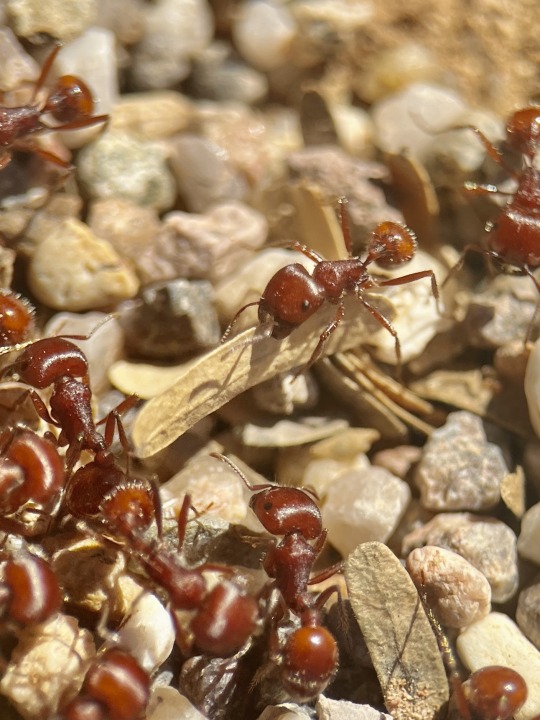

Harvester ants / genus Pogonomyrmex
Rated a 3 out of 4 on the Schmidt sting pain index, with their bite described as “inflaming your nerves for hours rather than minutes … bold and unrelenting.” The red ones also tend to be aggressive.
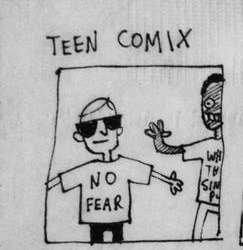
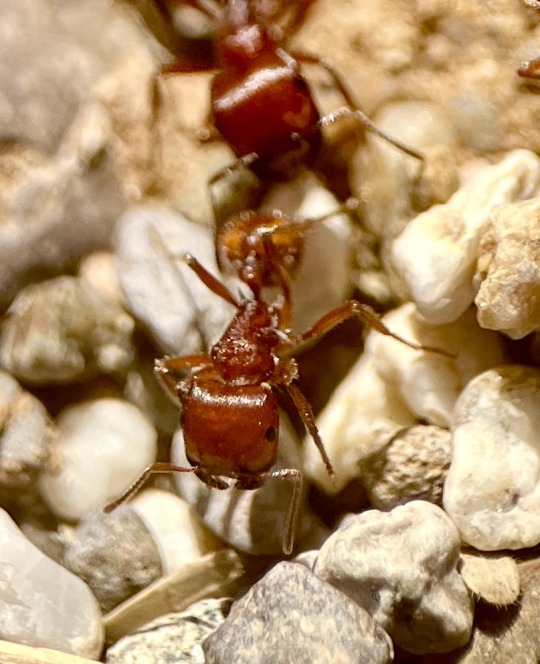

#insects#ant#ants#formicidae#harvester ants#my photos#seriously though I AM scared of these lol#or at least Concerned#just because I’m clumsy and flighty though and I’m scared of accidentally standing on their hill again
8 notes
·
View notes
Text
This is gonna bother me until I say it but as I rewatch the CAA I'm being reminded that people do think that queen ants "give orders" to the rest of the colony when there is no chain of command in an ant nest and the queen's role is grossly overstated
#idk why this is such a particular gripe for me but i just think it's cool that ants actually have more agency than most people think#the ''hive mind'' thing comes from how efficiently and effectively they communicate; not from any chain of command#i love ants i need more books on ants 😫 i read one at college and for the life of me cant find what it was#i even have pics of some of the pages but nothing seems to come up for them ://// it was about harvester ants specifically#i got 20 seconds into an episode and had a Moment hold on#hoatm rants
2 notes
·
View notes
Text
I was attacked by sudden desire to lie on the ground and watch ants. Specifically, I deeply crave to watch a nest of Messor barbarus, which is not present in my geographic location and which I had a chance to observe many years ago, abroad, for a few minutes maybe. Being a slave of own caprices and desires can be frustrating sometimes.
0 notes
Text
I never would've thought that plants could make me so happy until I started to propagate vegetables. Seeing these little green sprouts from my garlic cloves brings me immense joy

0 notes
Text
I had a nice time drawing a Pogonomyrmex occidentalis pupae today. I'm trying to improve my drawing skills-- There are many problems here.
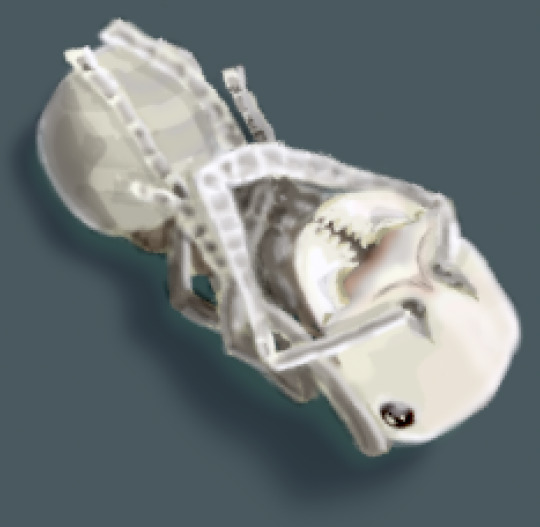
-shadow is off, should be more shadow under the gaster (I think?)
-doesn't look translucent enough
-It's overworked, but I claim that's my "style" (not really LOL)
-I made a mess with the blur tool. Had to clean it up, but it still feels blurred. No more blur for me.
-I don't know what I'm doing with that blue shadow It's supposed to be reflected light?
Like it's not bad, the mandibles look nice. And I feel like I understand the geometry of how ants fold their legs better.
Could not find a reference image of an ant from *below* to see exactly how the legs attach. Looked at one of my pet ants and annoyed her greatly!
#drawing#endless invertober#invertober every month#invertober#ant#pogonomyrmex#harvester ants#digital painting#art is hard
12 notes
·
View notes
Note
Wait, which animals raise livestock?
Several species of ants will 'herd' aphids around (a type of plant lice)- even picking them up and putting them back with the group if they wander off. The ants will attack anything that approaches their aphid herds, defending them. The aphids produce a sugary excretion called honeydew, which the ants harvest and eat.
Some ants will even 'milk' the aphids, stroking the aphids with their antennae, to stimulate them to release honeydew. Some aphids have become 'domesticated' by the ants, and depend entirely on their caretaker ants to milk them.
When the host plant is depleted of resources and dies, the ants will pick up their herd of aphids and carry them to a new plant to feed on - a new 'pasture' if you will.
Some ants continue to care for aphids overwinter, when otherwise they'd die. The ants carry aphid eggs into their own nests, and will even go out of their way to destroy the eggs of aphid-predators, like ladybugs.
--
Microhylids – or narrow-mouthed frogs - have an interesting symbiosis with Tarantulas.
While the spiders could very easily kill and eat the much-tinier frogs, and DO normally prey on small frogs, young spiders instead will use their mouthparts to pick up the microhylid frogs, bring them back to their burrow, and release them unharmed.
The frog benefits from hanging out in/around the burrow of the tarantula, because the tarantula can scare away or eat predators that normally prey on tiny frogs, like snakes, geckos, and mantids. The tarantula gets a babysitter.
Microhylid frogs specialize in eating ants, and ants are one of the major predators of spider eggs. By eating ants, the frogs protect the spider's eggs. The frogs can also lay their eggs in the burrow, and won't be eaten by the spider.
So it's less 'livestock' and more like a housepet - a dog or a cat. You stop coyotes/eagles from hurting your little dog/cat, and in return the dog/cat keeps rats away from your baby.
--
Damselfish grow algae on rocks and corals. They defend these gardens ferociously, and will attack anything that comes too close - even humans. They spend much of their time weeding the gardens, removing unwanted algaes that might overtake their crop.
The species of algae that they cultivate is weak and and sensitive to growing conditions, and can easily be overgrazed by other herbivores. That particular algae tends to grow poorly in areas where damselfish aren't around to protect and farm it.
Damselfish will ALSO actively protect Mysidium integrum (little shrimp-like crustacians) in their reef farms, despite eating other similarly sized invertebrates. The mysids are filter feeders, who feed on zooplankton and free-floating algae, and their waste fertilizes the algae farms. Many types of zooplankton can feed on the algae crop, and the mysids prevent that.
While Mysids can be found around the world, the only place you'll find swarms of Musidium integrum is on the algae farms that Damselfish cultivate.
Damselfish treat the little mysids like some homesteaders treat ducks. Ducks eat snails and other insect pests on our crops, and their poop fertilizes the land. The ducks can be eaten, but aren't often, since they're more useful for their services than their meat.
--
There are SEVERAL species of insect and animal which actively farm. They perform fungiculture and horticulture: deliberately growing and harvesting fungus and plants at a large-scale to feed their population.
Leaf-cutter ants and Termites both chew up plant material and then seed it with a specific type of fungus. The fungus grows, and the termites/ants harvest the mushroom as a food source.
Ambrosia beetles burrow into decaying trees, hollow out little farming rooms, and introduce a specific fungii (the ambrosia fungi), which both adults and larval beetles feed on.
Marsh Periwinkles (a type of snail) cultivates fungus on cordgrass. They wound the plant with their scraping tongue, then defecate into the wound so their preferred fungus will infect it and grow there. They let the fungus grow in the wound a bit, and come back later to eat.
8K notes
·
View notes
Text
Ant killer will be here any minute now..any minute…
0 notes